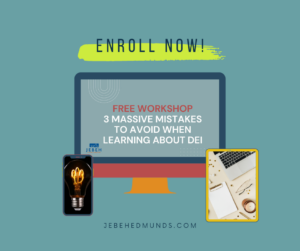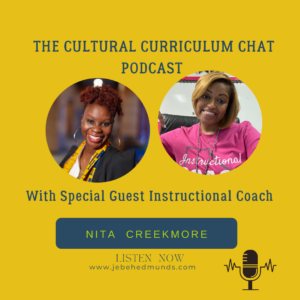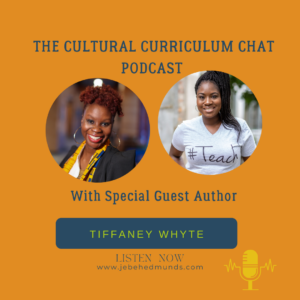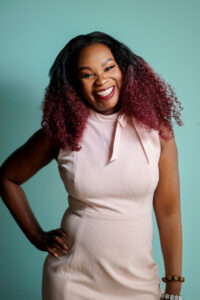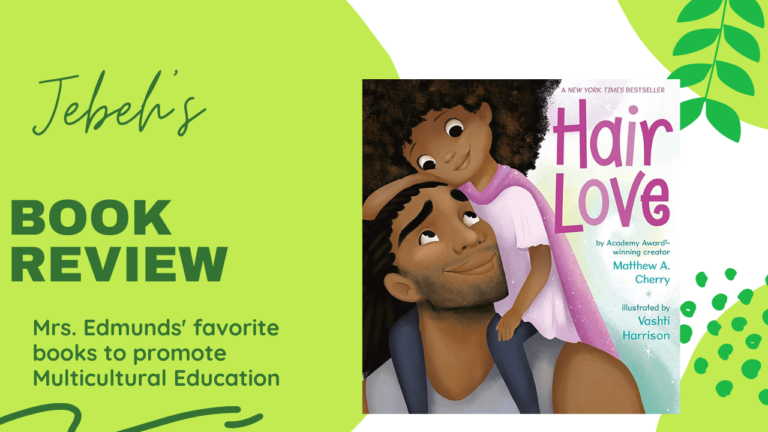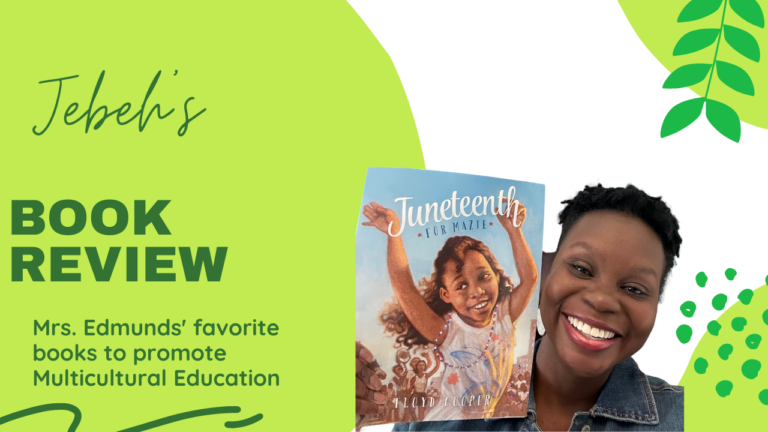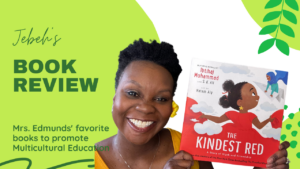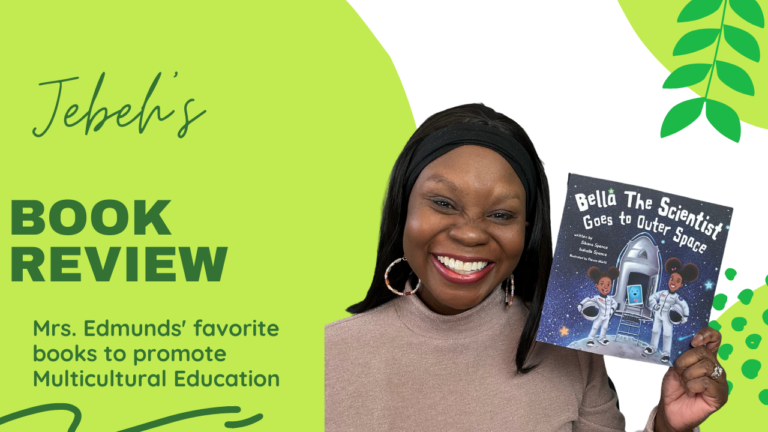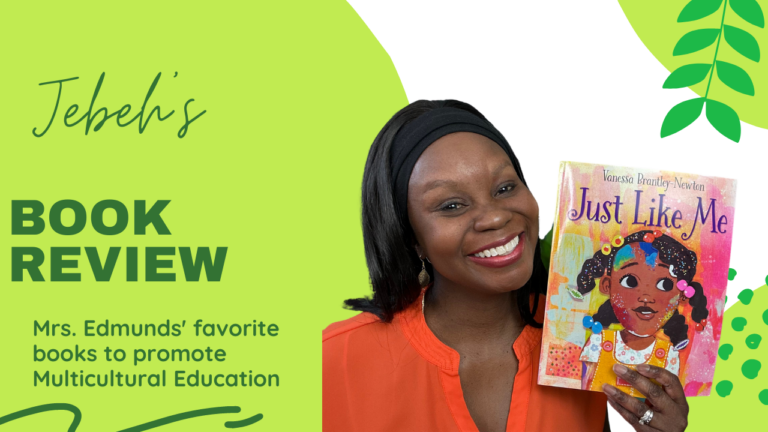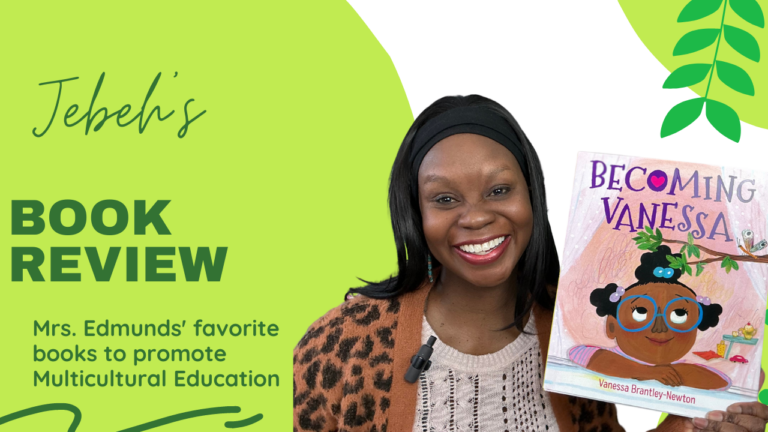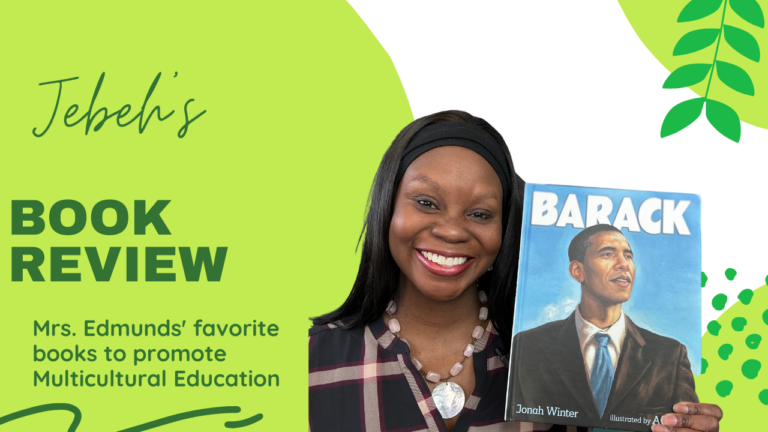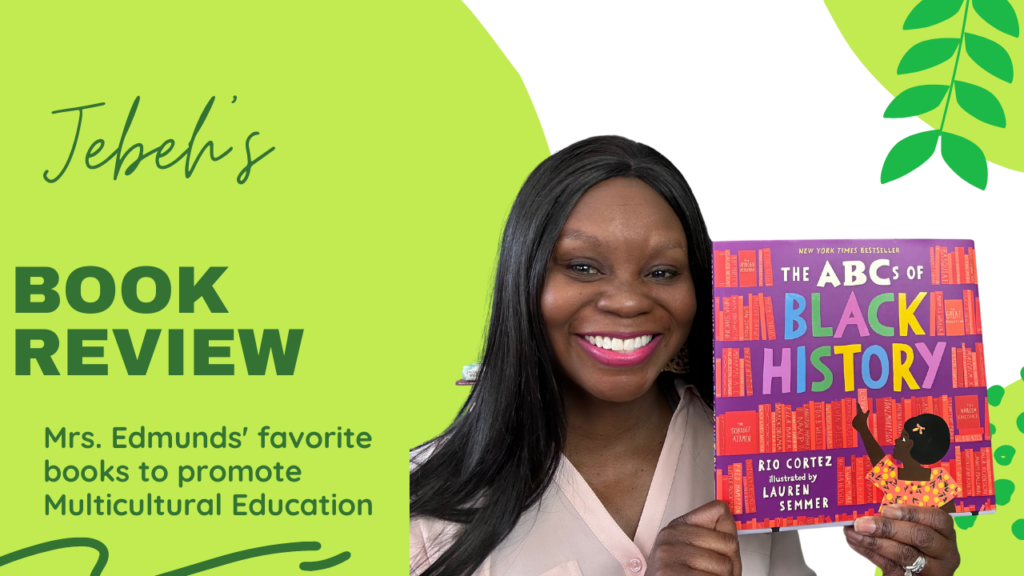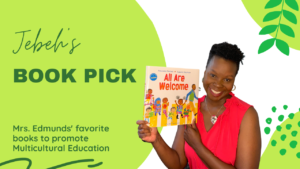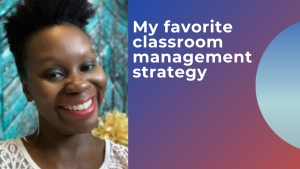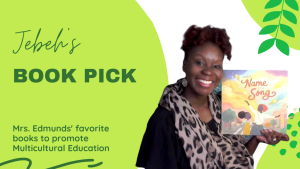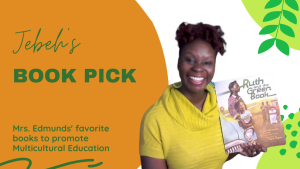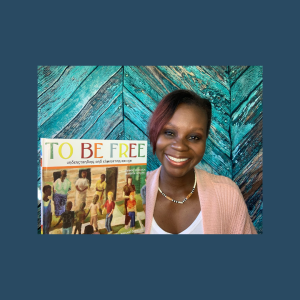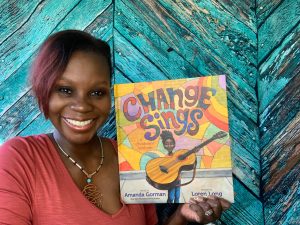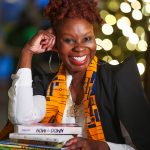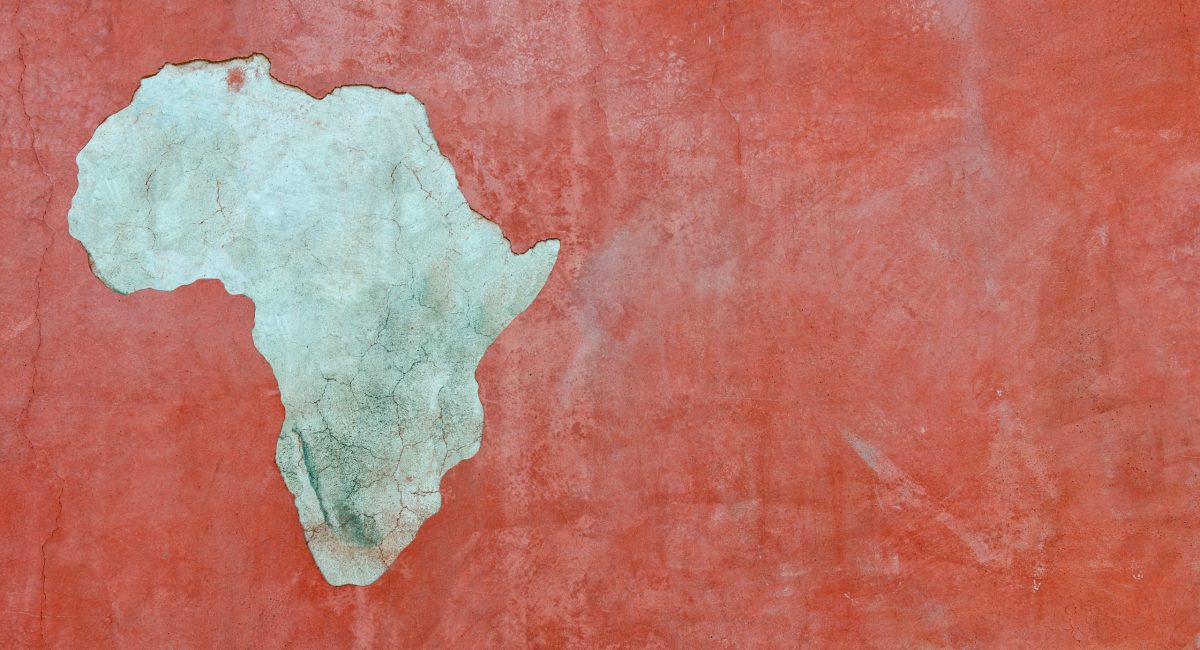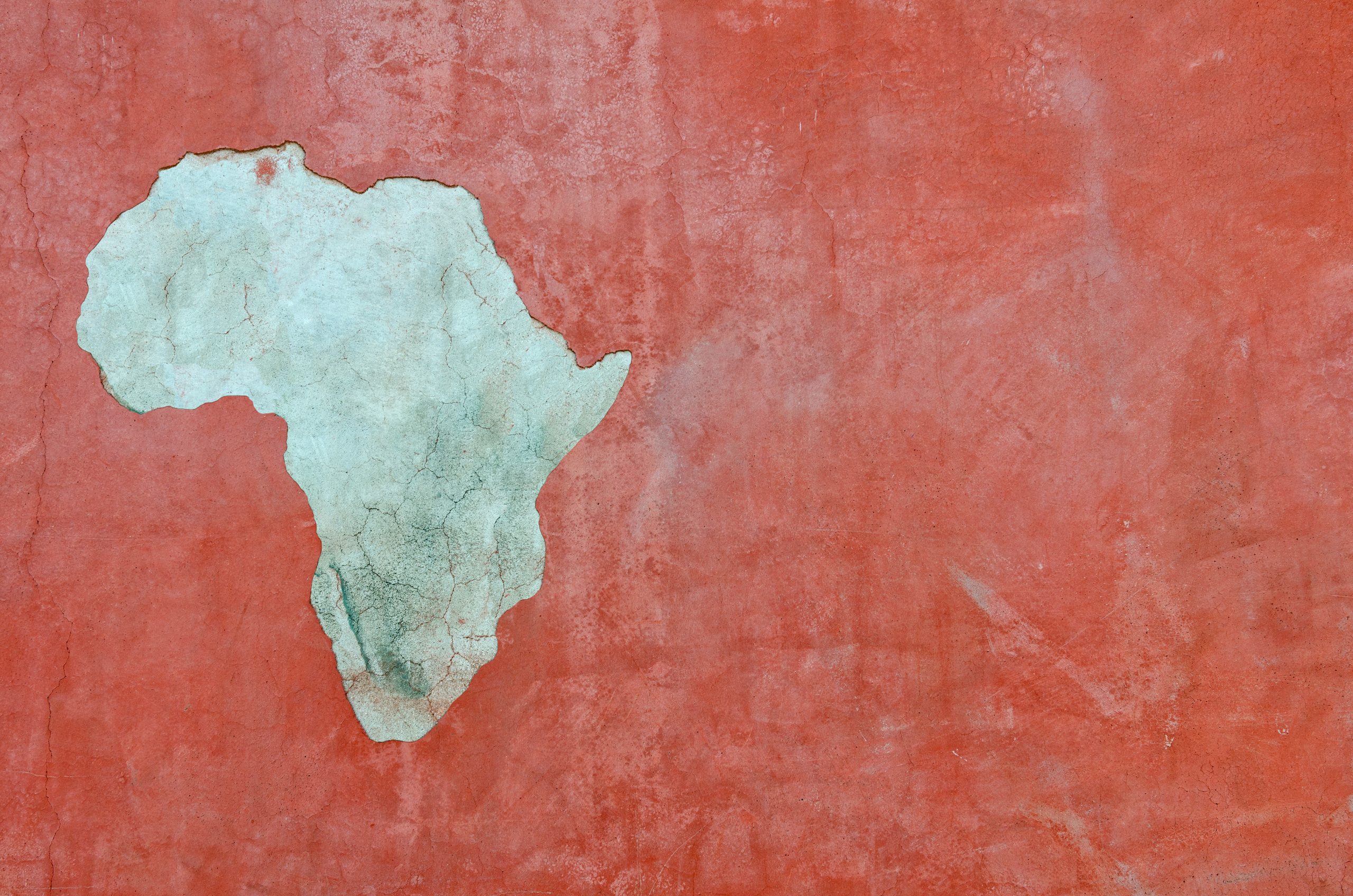You’re listening to the cultural curriculum chat, the podcast that specializes in multicultural education and classroom strategies. I’m your host, Jebeh Edmunds, let’s get started.
Welcome cultural curriculum chat listeners, Jebeh Edmunds here, so excited to have in the guest here today, educatorJamesetta Diggs. Jamesetta is a Liberian mom of two ages nine and seven, and an early learning coach, who has enjoyed serving in the field for more than 20 years, working with families and young children in different capacities as a preschool teacher, trainer, family educator, and early childhood consultant. She also enjoys reading and teaching the concepts from children’s books. She is amazed how books has helped her discuss sensitive topics and life skills with her own children. This is the reason why she started Social Learning for littles two years ago to partner with families of young and early learning educators. Since she has started her business, social learning for littles has served more than 500 families with activities to support children’s social and emotional development. In 2021, she published her very first activity book titled passport around the world for early grades focused on exploring the world people differences and self acceptance. And in her free time, she loves to journal and enjoy nature with self care, and hanging out with her children at libraries, tools, and watching animated movies to Jamesetta. And so happy you’re on the show today. Welcome.
JD:Thank you so much for having me. I’m so excited to be here.
JE:Oh, thank you. And I just wanted to share with you audience, Jim said and I met during the pandemic actually on the phone that my cousin introduced us shout out to Ngozi. She’s like, Oh, you’re in Minnesota as an educator, I want you to meet a dear dear friend of hers,Jamesetta Diggs. So I’m so excited to continue this chat and share with our audience, Jim Seta, you know, what is your story about education, especially with our young children?
JD:Well, I am so amazed at how children develop since I was young, I didn’t start off in education. I was actually going to school to be a counselor. So I was in Bible college and to become a Christian counselor. And I walked into the library one day, and I saw this book, child development, I’m like, and so I took it, I went home and I’d boarded. Like, I just went through the book. I was just like, wow, this is so amazing. And I’m just from that I went back home, I was studying in Ghana at the time, as a refugee, and I went back home to Liberia. And I was invited to this early childhood, like a workshop. And I was like, Okay, I went over and doing like, a group session, like a group discussion, I had an opportunity to share. And while I was sharing one of the facilitators during ROTC, she, you know, just like, and that’s how I’m here today. And since then, my journey started. And I’ve been here working with young children working with families, and it’s just been such a joy. You know, they say, Find something you love to do, and you don’t have to work a day in your life. So that’s where I’ve been in how I’m here.
JE:I love that Jamesetta Diggs. Because it is that spark, isn’t it like something that you had your path you had your mind going in one direction, and then That book changed everything, you know, for you. And so share with us tool with multicultural education. How do you tie that in with the young students with their social emotional learning needs?
JD:Being in the classroom has been so different for me, especially like coming to the US. I came to the US eight years ago with my family and it was a different like a different environment altogether. There was so many things to like, understand, it was confusing. It was like back pain that everybody’s Liberian, for a year. There’s so many different people. And so I walk into the classroom with this approach to like, take over the world like you want to bear to work with children, but then you start to see so many different things diversity, cultural languages, community, your home culture, so different in a classroom. You see how different people like living you start to understand Like, if you have to make an impact in children’s lives, you have to care enough to know where they’re coming from order to connect with them. That’s the only way they’re going to feel safe to be around you. They want to talk about the things they do at home, and you want to show them that you’re interested in what they do at home, that’s how . That’s how I begin to explore and learn and understand. And you cannot support a child, socially or emotionally if you are not connecting with them. And also understanding where they’re coming from. And supporting them socially, emotionally, even with your learning journey is based on how you connect and develop that relationship. And it has to be based on your background, and your why.
JE:Yeah, I totally agree with you, Jim said it, because it is the paramount of educators, we have to build those relationships. And I love how you talked about coming into the United States eight years ago. And it was a big learning curve, because you had to, you know, get to know your students through the various cultures of various backgrounds. Because as a student, if you don’t know my authentic self, who I am as you student, how are we going to have me feel safe enough to learn what you’re going to show me, right?
JD:Yes, that’s it. Exactly. And that’s the approach, that’s the only way we’ll be able to like those little lives and show them, they love their teachers, they love their learning environment, they also need to know that they’re safe, they’re respected for where they come from, like it, it makes a big difference in a child’s life, if they come to school, and you can say all that, or you can say olla you are you can say something in your language that like just like something like that spark, you know, or you can ask them or show them a picture of something that is from their culture, and they can relate is so amazing.
JE:It is amazing. And also that you took the time to learn a greeting, you took the time to find that picture. And that child just sits a little taller, because they finally feel seen, they feel validated, that you see them for who they are, and where they are, you know, socially and emotionally too I think educators need to be and accept that each child, you know, needs to be accepted for who they are in where they are emotionally. I feel like some of us educators, we get so motivated and like, yes, I want to do all the things and some littles are like, oh, hold up, we just met, we met a week ago, like I’ve just first six weeks, like I’m just still trying to get to know you. But eventually you’re right, that relationship and that bond that you have with that student gets stronger throughout the year. And I love that tip that you’re sharing with our listeners that yeah, some little strategies that’s quick, actionable, you can find stuff on Google Translate to find the language that they speak at home to share as a greeting. When you do your morning meetings and stuff with your students. little simple things can go a long way.
JD:Yeah, in connecting like when children can connect like they’re exactly what we’re seeing is that they’re different children in the classroom. So like a child will, the way a family is putting their child to bed is different from how the other family is putting your child to bed. So if you see two children playing in a play area, and you see another child is king, your baby, and another one, just live them there to go to bed. And they’re like, looking at it a confused level. That’s where you connect them because you’re now in a position to teach that they’re both different. And by teaching them ,how differently they are, and but they’re also like important and so special, that’s a different way we do it, you’re helping them connect to another family. And also you’re enriching your idea of how different the world is. So like creating that opportunity for children to connect and feel safe, is such a big deal goes a long way. In this subject of diversity, the subject of equity that we’re talking about. It starts right there, those little things that we do in the classroom with our little ones.
JE:Yes. And also Jamesetta, can you share to the importance of catching our little ones with equity and multicultural education as them being little to give that foundation because I feel like a lot of us adults that aren’t in the educational space are saying, well, we’ll get to that diversity when we get there. Right. I mean, kids are seeing people by their skin color. Very young. I remember when my oldest was three could tell you know, skin tone differences. So what can we share with those parents and girls? mumps out there, why it’s so important to have these discussions in early childhood with, like you said, how a mother cares for their babies? Like, how can we share with them how important it is to start those conversations. at that early age.
JD:One of the things I would say Java is I like to teach children to books. That’s basically what I do as an early learning coach, and books. They’re such great opportunities for children to learn, and discuss and understand, like difficult concepts. So if I come to a child and try to clean it, oh, everybody is different. What does that mean to a child. But as children learn by the books they read, by the way we interact with them, they’re in a classroom of children of different skin color, I know my son used to say Korean people. And so they’re in the classroom with different skin colors, skin tones and different languages. So as we talk about, we read books, as we read books in the see the pictures, how another friend says, Hola, how another friend says, bonjour, how another friend say Good day, or another friend, say morning, or whatever they’re seeing those things. They’re seeing the examples. And one thing I will always encourage parents to do is to talk about those things. Do not hold back, because as you create awareness for your child, there is a string, there is a line, creating awareness not only sparks all that confidence in your child, but then you extend it to the point where your child become an advocate for another child becomes an advocate for themselves, they become like the seat justice. That’s where equity comes in. Because they know that we’re different, but we’re the scene where equal array, we’re in the same classroom, we share the same books, we share the same toys, everything is available to us. So that puts our children in a place to be able to understand, oh, this is what it is, rather than just taking that big woe is diversity, we’re going to talk about it, you don’t understand what it is they do in different ways, by examples, in different ways, by everyday things that we do in the classroom, our lifestyles, the way we talk to them, we interact with them that the way we connect them to stuff. And so all of those things play a big role in your lives, in helping them understand teach diversity to them, and helping them understand that whole concept of diversity and equity.
JE:Often, Jamesetta , you nailed it, my dear. Yes, all of the things. And I feel like you said with that string of learning, they see the examples in the book, it’s a great conversation starter, you’ve got students that when they come into my classroom, you know, when I used to teach fifth grade, they had the foundation already laid in place from the beginning. And then it gives them like you said, that confidence to advocate for themselves, and to advocate for their classmates that don’t look like them speak like them, think like them, it all just comes together. When we start at the very beginning off, you are so right. And I know, because we are I know, it’s like we’re cut from the same educational multicultural educational club. So our kids have, you know, the big library at home that is very rich in diversity. My question for you, Jamesetta , as a parent, what have you experienced with your children, when it comes to multicultural educational space?
JD:There’s been a lot when I first came to the to this country, my son was almost two. So there was this preschool part of it. And there are lots of programs that I didn’t know what to do. Like, there was like Valentine. And they would have like, fall parties and all these parties. I did not know what was expected. I did things in a way like and then after, I’ll be like, Oh, that’s how it it’s done. So like, in that space, I understand how families feel like when I work in the classroom, and I started working in the classroom, I understood like if up here and like some of the African parents would come and some of our teachers we wonder like, I wonder they taught the message right? And I would explain like when I was a period in preschool, I understand what what this parent is coming from because the way we get the message is totally different. So sometimes is really important. Ask the parent after you send all those communications is important that experience did you remember I send it Do you have any questions? Are you okay? Are you with everything? Is there anything I can explain? I know sometimes you’re afraid because you’re thinking that you don’t want to sound pushy, or you don’t want to sound like you’re crossing the line. But it’s always good to check in. Specially with our culture, background families, like families that are culturally different. You have to check in with them to understand how are they receiving the message. So those are some of the things that really like, came to me as a parent when I came here. How is it done here? I knew I had to learn it. So now with my daughter, I was like, Oh, yeah. Oh, how is dark? Because I’ve experienced it. So like, I always try to be an advocate for families and African founders, until the year did you know that this is what they wanted, and can do checking to ask the teacher what they wanted. So that’s phase of checking the educators checking back, understand what they’re actually sending ads, I definitely will see. Because it happens.
JE: And you know, to the assumption as educators of well, they speak English, they’re just going to go along with what we do. And so even just take a minute or two to research, not everybody celebrates Halloween. Not everybody goes and has turkey for Thanksgiving. Not everybody has these types of Americanized rituals and traditions. So in the classroom, in a funny story, I came when I was two, and I was the guinea pig for my mom and dad. Okay, look, I did the same. You know, I remember my mom, she will never tell the stage um, Zetta get a pumpkin for Halloween, because she had the Enter Headstart, like you’re gonna have to make a Jacqueline earning, cut and do that with the pumpkin with the night. And she said, I cry, you’re killing my pumpkin. She goes to this day, I’m 42 and a half, she’s like, I will never have pumpkin in this house again, because she was like, I don’t know what to do. We’ve never had Halloween in Liberia. But that assumption, it’s Halloween, we’re gonna make our jacket lanterns. Let’s do this. And she said for her to like, feel like she’s traumatizing her child. As an educator, we just have the assumptions of hip, here’s a little sheet, a little craft, you bring home and do it with your parents or your grown up at home. And everything is good. And as an immigrant parent going, oh my gosh, I am traumatizing my child has.
JD: And I And Greg to go like what you’re saying with the holidays and everything? Just like what would it be like? If you asked children? What did you have for Thanksgiving? You know, draw what you have for Thanksgiving instead of everybody bring you home with Turkey. Like I know our family. They were so stressed over like getting a turkey. And I always tell my children, it’s a holiday, we’re making an African dish. And everybody’s so excited about having an African dish because like you don’t always get to make African there’s so there’s a holiday we’re home. That’s making African dish, making no turkey. So when you come back, my daughter said I would draw the chicken feed I say whatever. Just let them know. That’s what we have. And it’s what we do in our family.
JE: And yeah, and even you said special occasion. We’re with our families. This is our special occasion feasts that we have, you know, and I think for students to share what they have at their table and be excited that it’s not always going to be the same menu in every household. Right? And that’s what makes our classroom unique. Ah, I tell you Yeah, so I love how you shared so far,Jamesetta , greetings, getting to understand your students from all the various backgrounds and celebrating that starting those conversations with books proactively and reactively. When things come about what else I really want you to kind of share with our audience more about your business and connecting families with that social emotional cross cultural learning.
JD: I started, like I said, we always read books were educators. We got the kids making the bugs reading the books. We always read books During COVID, my daughter was like, she was so bored. And she was so like, restless, there was so much that we couldn’t do. And we started exploring the books that we had. And while we were exploring, I started like, making informations out of those stories. So like, I asked her one day, like, this book that we read, what can you say about yourself? Like, how can you affirm yourself in his book using I am, and then she went on and on and I am special I am I am. I’m like, wow, this is amazing. So then we started reading books every night. And then we will go through like the affirmations. And then I’ll ask, okay, what did we use I sentences. And then we started using I have I, am, I will, and then it started coming to me. So that’s how I develop social learning for littles with the everyday possibilities using the books. Because in every book, if we use I am, it creates that position for the child to affirm them. So that’s self awareness. That’s self care. And then I have children start to practice gratitude, what they focus on what they have, rather than what they don’t. And then we started to see, I can’t like if there’s using canned sentences, and then I will then say, well, this can help them set goals if they’re saying I will. So I developed this framework called the everyday possibilities framework with books that I use with my children. So every time we read the book, I started bringing out these statements and these questions for feedback, rather than what is the story about what did you learn from the story? What if we ask questions about how we felt about the story? What if we ask questions? If you were in the story, how would you solve the problem? Right, those kinds of questions, and then it started to go on. And with every book, I started to see more and more of these things with my children. So during difficult times, and during challenging times, and that started coming back in everyday life and everyday skills. And it started reflecting I started to see the effect of books in my children’s lives. I’m like, Well, this is important for other families, how many families can I encourage to do this with their children. So I developed that growth mindset framework. And I started to share it, and I posted it all over social media, and there was like, people were so like, interested in it. And they wanted to know, so that’s how I developed like the program for social learning for littles and then continue with the books and everything. So that’s the story behind that.
JE: Oh ,I love that you set up because I have that’s how I’ve been following your whole journey and your affirmation cards that you can frame and put up in your house. And the books you’re suggesting with the littles and just your whole philosophy. And I love that with their self affirmations, their goals, and what they want to do to keep going forward. And like you said, there will be times in our children’s lives where they’re going to be stuck, and to retell about a story that you had that with your child, and having those conversations opens up their confidence to be themselves and feel like they’re in that safe space with you. And seeing you guide them along the way. That’s just so powerful. Yeah, now that’s amazing.
JD: And remember our whole story during the George Floyd situation, the books helped me it was a difficult time. It was not a time I could hide it from my children. My daughter was five, turning five at the time. My son was around seven at that time, how would I discuss these things with my children? So I use stories about writing stories about justice, stories about racism, like books that have been written, and I’m so grateful for the books that are out there before 10 years ago, our children wouldn’t have had access to these things. So I always encourage educators, I know we have all of these great books that we have from the past that we have in our classrooms, but they’re great books coming out. Use those books. Talk about these things with your children. Develop a study around some of these topics. Make it like fun in the classroom, to story cards, ask questions, explore tick them outside do like an exploration with the book and learn the concepts and the things that the books are teaching these children. There’s so much embedded in this. I know we’re not bookworms, my kids love so many other things, but they’re just like that part that have worked for me and I believe can work for so many families, culturally, because there are so many books that are multi cultured. There are so many diverse books. And so it’s so important that we can find these lay our hands on these and use them for our children’s bright future for their noun their development, their growth, their learning. In everything, .
JE:Yeah. Oh, yes. And like you said 10 years ago, we didn’t have half of the books that we have right now. And yes, when the George Floyd murder happened, it was we were all as parents grieving. And as black people going through that trauma again. And books were the way to have those conversations with your children in a safe setting where they can ask questions, and go through it together. Offense is awesome. And yeah, all I always wholeheartedly tell my teacher, friends, if it’s older than 15 years old, you got to do some pruning, because there’s tons of new titles out there that are waiting to be in your classroom. And a lot of things like I tell my former students to the more you know, the more you grow, and there’s some books that haven’t grown and learned some years. So there’s some times you just might need to recycle some things and get some new titles, new characters, and new biographies of people that are in the now that are current in our students development as well. Oh, my goodness, this is awesome.Jamesetta , one more question. Before we go. You’ve given us so many great tips and tricks. Is there anything else you would like our listeners to do with your work? How can they follow you and find you?
JD:I’m on Facebook and Instagram. And I also have a website social learning for littles.com. There, I use it as a blog site where I share the books that I read with my children or with my small groups. So the books are on there. And if they’re looking to find books, the one book lists List of books or have books, they want a future let me know about it. So yes, if you look up social learning for littles, you will find me that’s me. And I love sharing my journey. I love encouraging families. I love working with families. I love working with educators. It’s been a joy in this space of learning and growth in everything that we’ve been doing so far. I just want to encourage everyone out there, just be aware of who you are. Be conscious of where you’re at. Don’t make assumptions. Everybody’s different. And just create opportunities to connect with other people and ask questions. Don’t be afraid to ask that you offend. If you think you’re offending somebody, you can apologize or ask them a better way still ask. You never know people say the stranger who asked never misses the way. So that’s really important. Ask questions, don’t make assumptions, and just connect with people. You never know what you know, I have so many friends from different backgrounds and different races that I love. And I enjoy spending time with.
JE: So yeah, that is it. It’s like you said that authentic human connection that goes a long way to understanding who we really are. Yeah. Oh, goodness. And yes, listeners, I will put all of Jamesetta information in the show notes so you can continue to follow her journey because it’s an amazing one. And the books you have shown a girl I have purchased them myself to share with my nieces and nephews. And yes, I really love your book recommendations.
JD: I have a present for you. Actually, do I have a book that’s on its way from Liberia? Written by one of our really own good, hard work in Brenda Moore. And so I got three, she got three of her books that’s coming to me.
So I’m a huge fan of Brenda Moore. Rand is only fangirling right now, though. Yeah,
you’re getting one of her books. I will send one over to you. I have one for my library. And I’m thinking about how I can share the third one.
JE:But yes, just I didn’t want to say it. But I have to kind of cry thing here and shout it to Brenda Moore. And yeah, another amazing writer and multicultural educational guru based in Liberia. And I tell you, my grandfather used to say this was his biggest mantra was you educate a man you educate an individual, but if you educate a woman, she will educate her whole community. And that has been I tell you the reason why I’ve done this business and sharing as much multicultural resources that I can. And I’m just honored to be walking alongside you jamesetta carrying that charge of bringing more multicultural education on resources to all of our families. So I’m honored to speak with you today.
JD:Thank you, you inspired me every day everywhere is diverse and just teaching those concepts and those truths about it is so important so it inspires me I tell you like it really does a keep doing what you’re doing. It’s very important.
JE: Thank you oh, means a lot and yes guests thanks for listening and will see you next time on the cultural curriculum chat.
